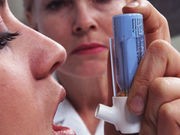

Americans with chronic obstructive pulmonary disease face high out-of-pocket costs and other significant barriers to adequate medical care, a new report finds.
“This report reveals a real patchwork of care for patients with chronic obstructive pulmonary disease,” the report’s lead author, Dr. Meilan Han, said in a news release from The Lancet Respiratory Medicine.
The report, written by experts in the field of respiratory health, was commissioned by the journal to provide the first comprehensive look at chronic obstructive pulmonary disease (COPD) care in the United States.
COPD is the third leading cause of death in the United States, Han said. And the condition disproportionately affects some of society’s most vulnerable people, such as older people and those with low incomes.
Many COPD patients lack access to medications and treatments that could improve their quality of life, said Han. She is medical director of the University of Michigan’s Women’s Respiratory Health Program.
“As a physician, I can discuss best treatments with my patients, only to later find out it isn’t covered by their insurance, or the co-pay is simply too high. This report aims to move us from debating what ideal care could look like, back to a discussion of what patients are actually facing on a day-to-day basis,” Han said.
COPD is an umbrella term for a group of progressive lung diseases, including emphysema and chronic bronchitis. People with COPD experience worsening breathlessness. Treatment for the condition usually involves inhalers and other medication, as well as pulmonary rehabilitation, the report authors said.
Smoking can lead to COPD. But there are other environmental risk factors for the disease, including long-term exposure to wood smoke or air pollution, the experts noted.
In the United States, about 15 million adults have been diagnosed with COPD. But, nearly 29 million people may have signs of the condition, indicating that about half of those with COPD remain undiagnosed, the report said.
Access to COPD care has improved, but patients with the disease can have out-of-pocket drug costs of $75 or more for each medication they need to take. As a result, many patients skip doses or cut down on their doses. In some cases, people simply may not refill their prescriptions, the study authors said.
The report showed that only half of COPD medication doses are taken as prescribed. This compares with about 75 percent of drug doses that are taken properly for other chronic diseases, such as diabetes, high blood pressure and heart disease, the study authors said.
Patients have reported that pulmonary rehabilitation was the most beneficial treatment for their quality of life. But access to this therapy is often limited by insurance coverage. And, in some cases, patients don’t have access to this treatment in a convenient location, the report authors noted.
Every year, COPD results in more than 10 million doctor visits, 1.5 million trips to the ER and nearly 700,000 hospital admissions. One in five people admitted to the hospital for COPD returns to the hospital within one month, draining resources, the report revealed.
Researchers have also found that only one in three hospital admissions adhere to standard recommended care guidelines. The authors suggested that a lack of written protocols for hospitalized patients may make COPD a low priority in some hospitals.
Most re-admissions for COPD are the result of poor access to care or support outside the hospital, the study authors said. They suggested that preventing hospital re-admissions for COPD through better diagnosis and access to treatment should be a priority.
Therefore, more education for COPD patients and doctors is needed, the study authors said. In addition, doctors, drug makers and insurance companies must work collaboratively to ease the financial burden on COPD patients. This could boost patients’ adherence to their treatment plans and reduce overall health care spending, the report concluded.
The study was published May 13, and the findings were scheduled for presentation May 17 at the American Thoracic Society meeting, in San Francisco.
More information
The U.S. National Heart, Lung, and Blood Institute has more about lung disease and conditions.
Source: HealthDay
Copyright © 2025 HealthDay. All rights reserved.

Leave a Reply